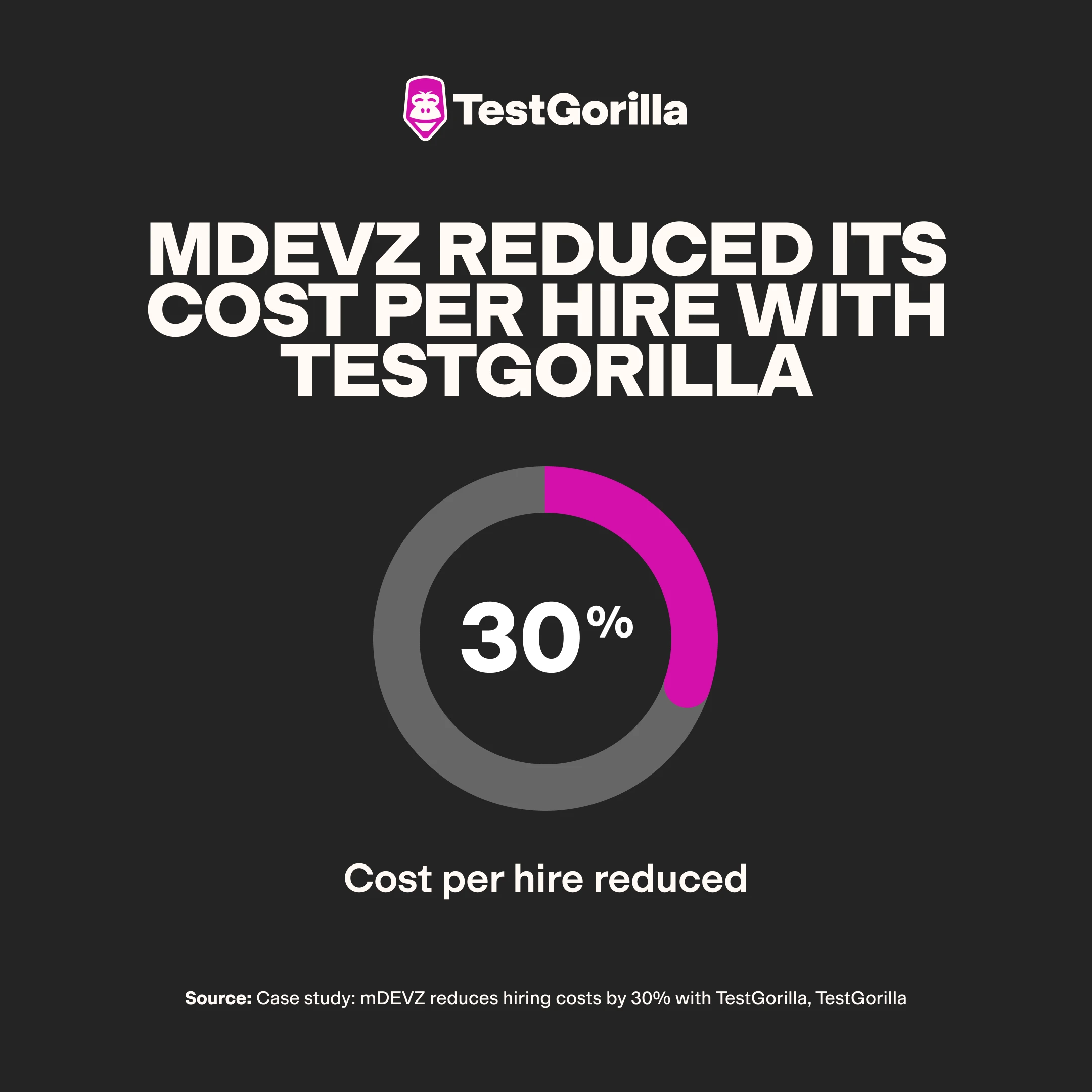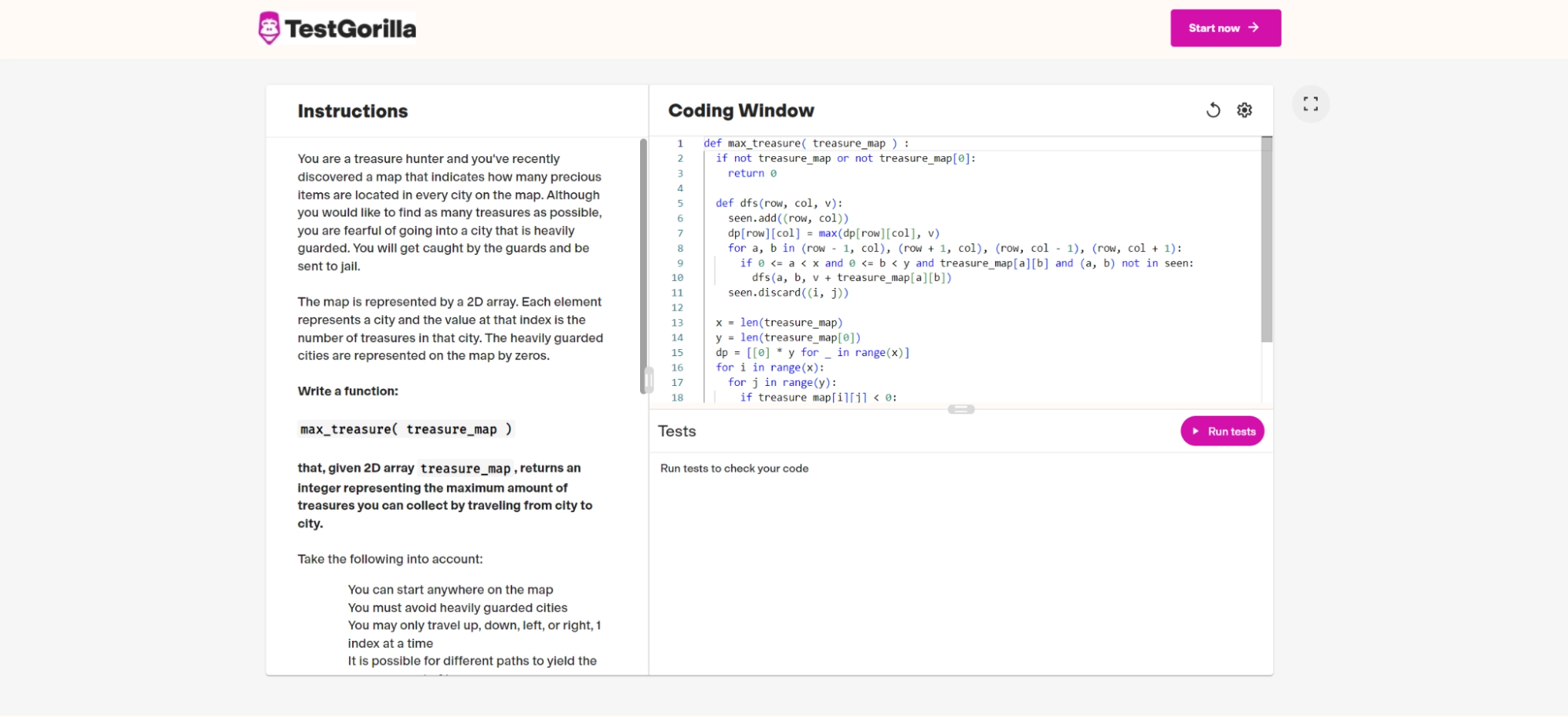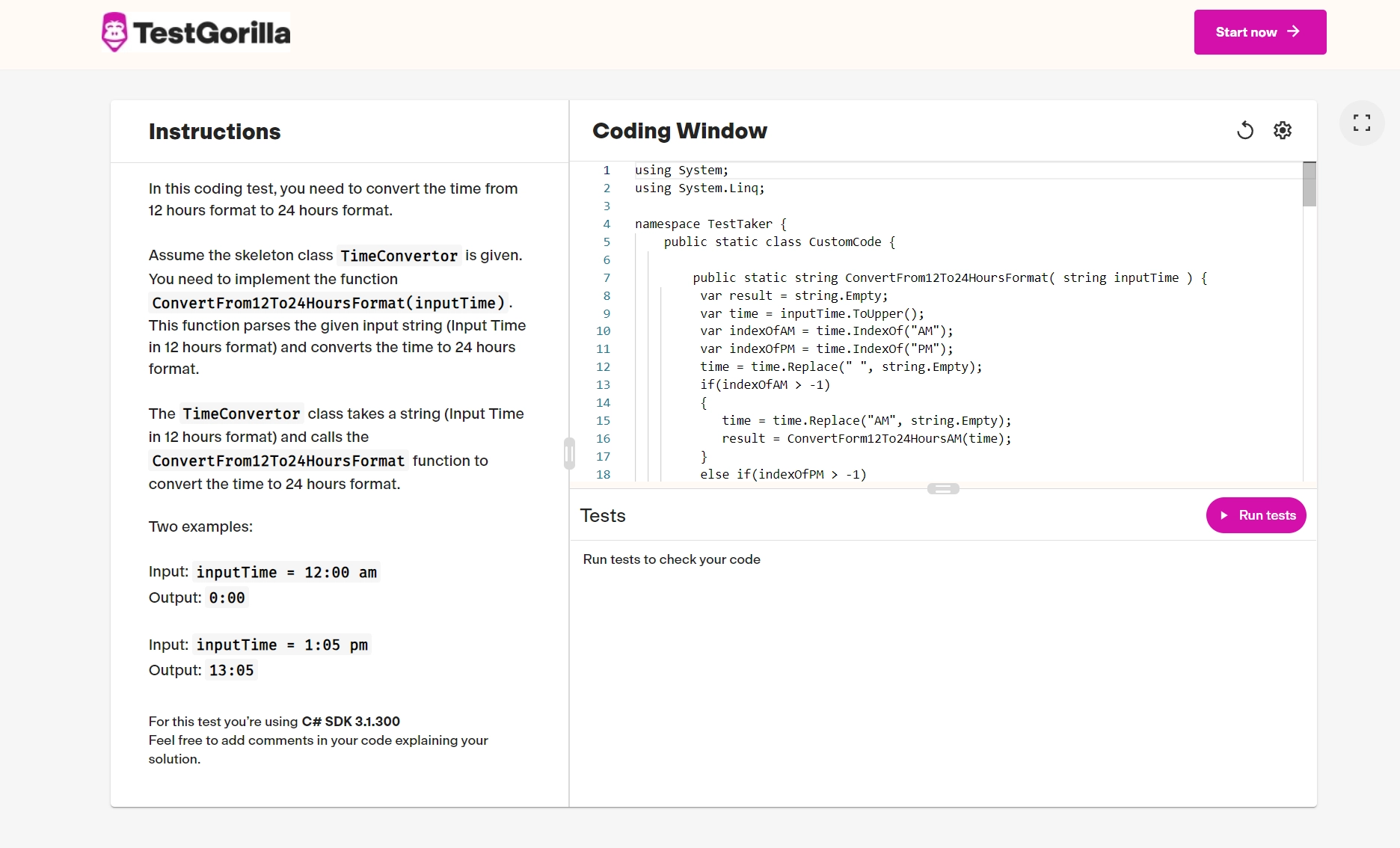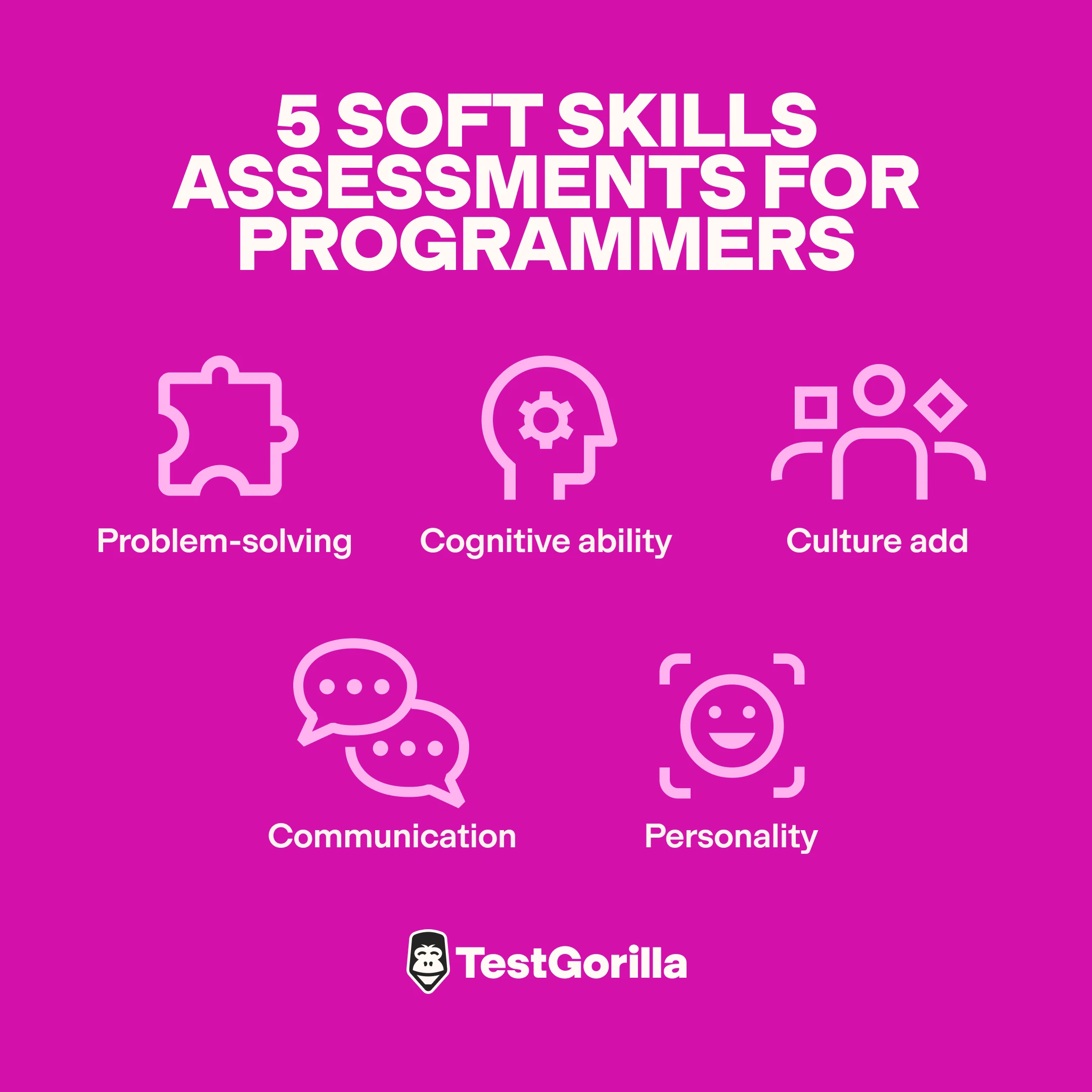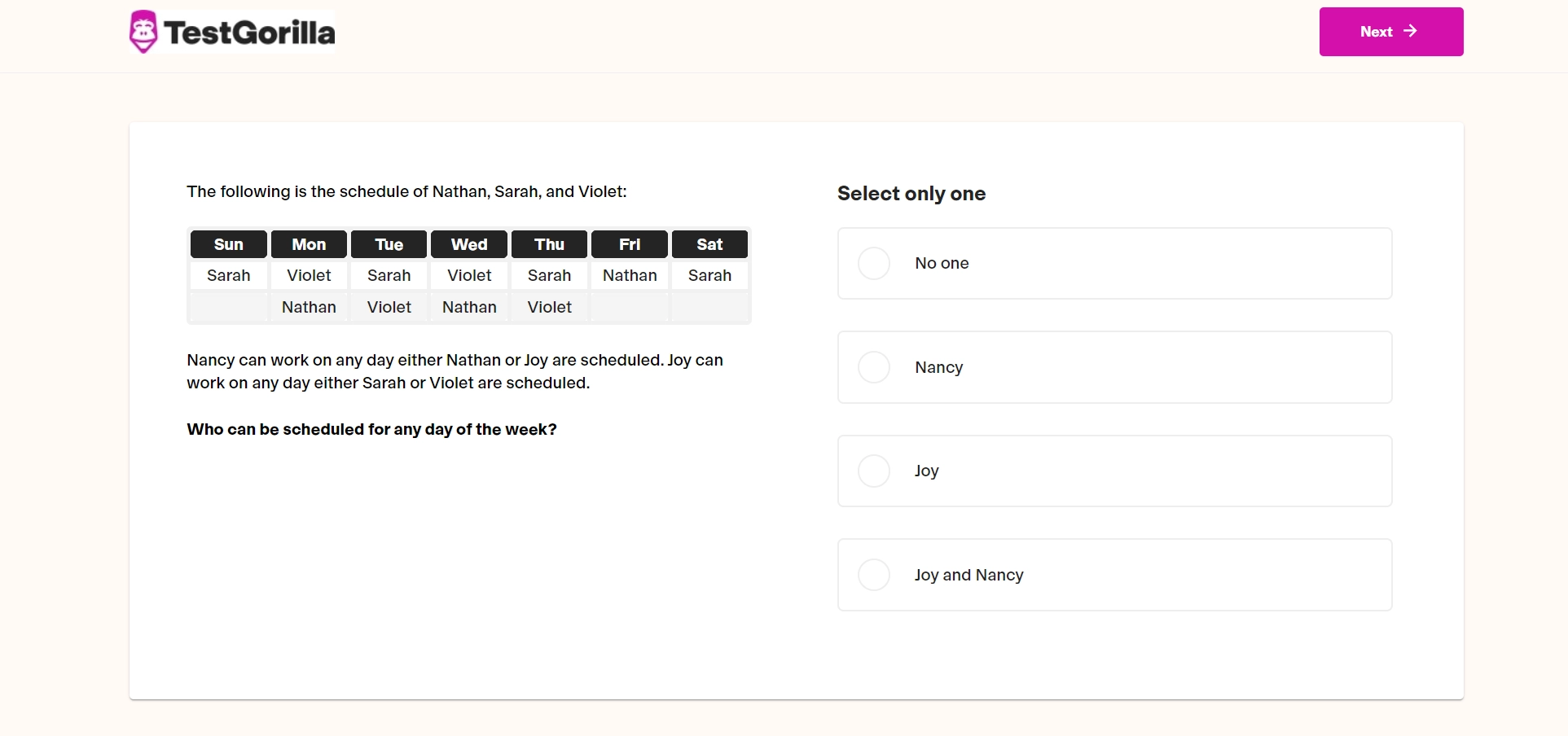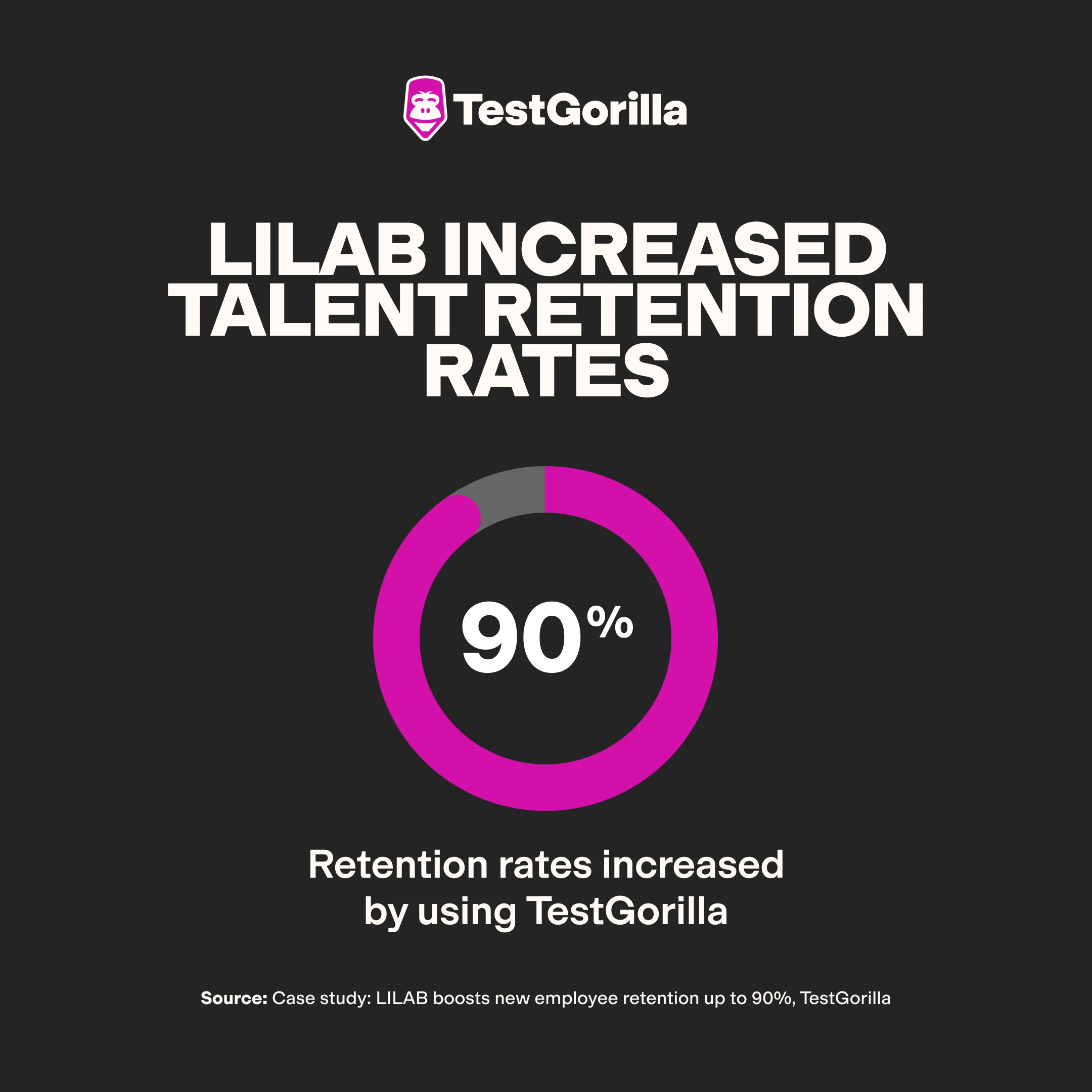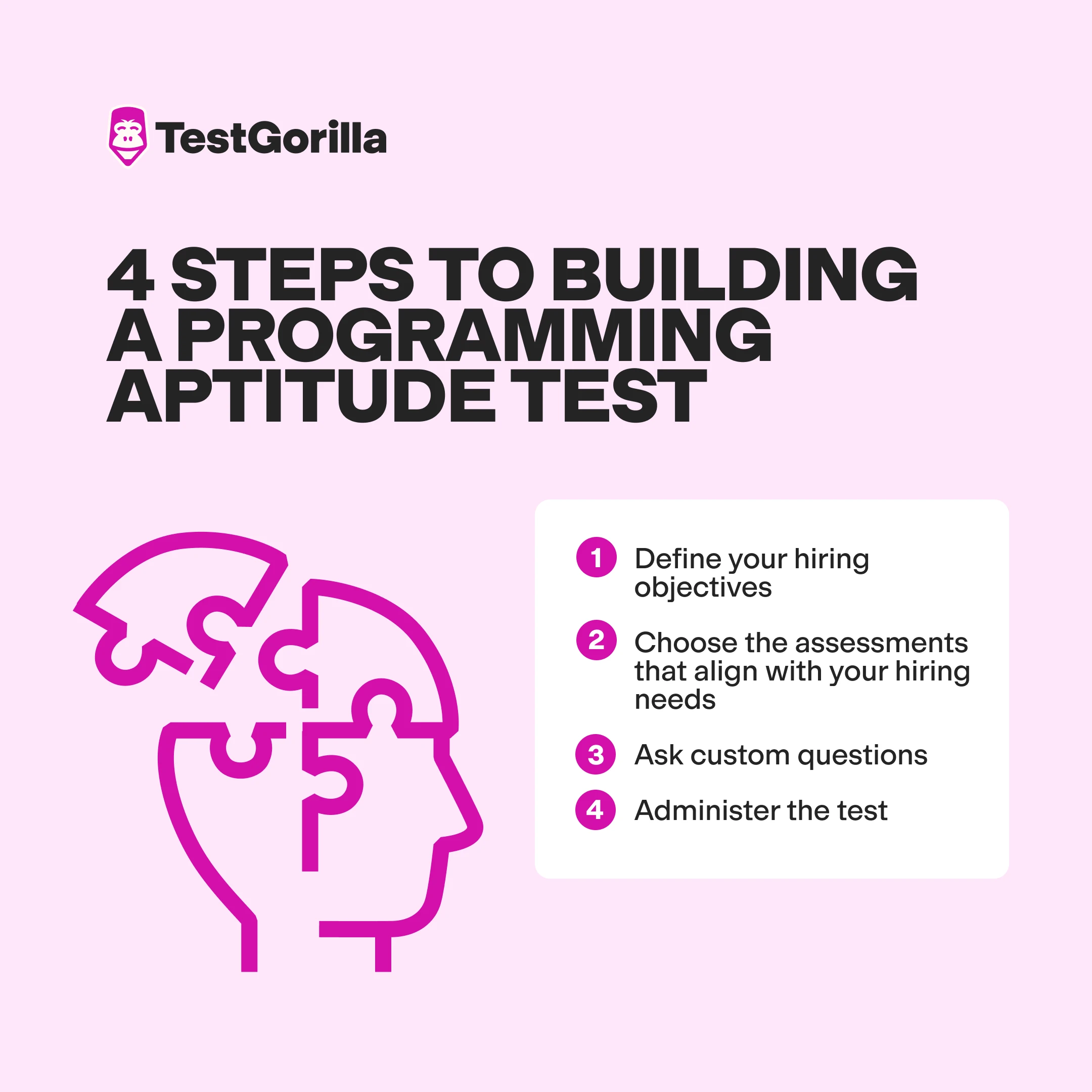Screen candidates with programming aptitude tests from TestGorilla
Hiring a programmer with the perfect blend of technical knowledge, soft skills, and a deep understanding of programming languages is hard because validating crucial skills based on what you read in a resume is impossible.
As part of a comprehensive talent assessment, a programming aptitude test evaluates the core skills candidates need to thrive in the role.
The insights gained from a programming or coding aptitude test make it easier to compare candidates based on their competency, reducing bias in recruitment.
In this guide, we discuss the programmer aptitude tests for your screening process.
Table of contents
What is a programming aptitude test?
A programming aptitude test gauges how candidates solve complex programming problems with logical reasoning, mathematical skills, coding knowledge, and algorithm abilities.
If you’ve tried to hire a programmer based on a resume, you know how difficult it can be to get a clear insight into their skills. Resumes are unreliable and don’t prove practical or technical skills.
Just because someone lists JavaScript knowledge or a computer science degree on their resume doesn’t mean they have a comprehensive understanding of imports and exports, typecasting, or event bubbling.
On the other hand, a test for programming aptitude gives your HR team the ability to:
Identify critical skills in candidates: Talent assessments enable candidates to demonstrate their skills by answering questions and solving relevant problems.
Reduce unconscious bias in hiring decisions: Unconscious bias is common in the tech industry, where up to 91.88% of software developers are male. Aptitude tests enable you to compare candidates based on skills rather than traits, reducing the risk of biased hiring decisions.
Accelerate the hiring process: A programming aptitude test can replace resume screening and inspire interview questions, showing you areas where candidates show expertise.
Aptitude tests help hiring managers make better hiring decisions. For example, using a programming aptitude test as part of its candidate screening process, mDEVZ, a software development company, reduced its cost per hire by 30%, increased talent retention rates, and improved shortlisting time and the candidate experience.
Screen candidates with programming aptitude tests from TestGorilla
Choose from various programming aptitude tests offered by TestGorilla to create the perfect talent assessment for your hiring strategy.
5 programming aptitude test examples
The best test for programming aptitude depends on the type of programmers or IT experts you want to hire. Many computer software and programming aptitude tests examine a candidate’s knowledge of specific programming languages like Java.
Let’s look at a few below.
1. C++
C++ is a powerful, multi-purpose programming language used to develop operating systems, applications, and web browsers.
If you’re hiring a beginner to support a development project, you can use tests like the C++ (Coding) Entry-level algorithm test to check if your candidates understand the characteristics of C++ as a programming language and how it differs from C.
If you need a more seasoned programmer, TestGorilla’s C++ (Coding) language-specific concepts test evaluates a candidate’s knowledge of different data types in C++, such as the “auto” data type, vectors, and numbers.
2. Python
Python is an interpreted programming language used to create websites, programs, and systems integrations. An entry-level programming aptitude test for Python evaluates a candidate’s knowledge of crucial programming concepts like modules, tuples, and lists in Python.
Hiring managers can use advanced coding tests, such as our Working with Arrays test, to further probe a candidate's Python knowledge. This test asks candidates to write functions with arrays, following specific instructions, like the example below:
3. Rust
Programmers use Rust to create memory-intensive applications such as operating systems and browsers. Many Rust developers need a combination of skills with Rust, JavaScript, and Cargo (a package manager) to thrive in their roles.
Programming aptitude tests, such as the Rust (Coding) Intermediate-Level Algorithms test, evaluate how well candidates can write functions in Rust code, maintain a Rust codebase, and optimize Rust packages using Cargo.
4. JavaScript
JavaScript is one of the world’s most popular programming languages for front-end development, software engineering, and web app creation. In 2023, 52.93% of companies sought employees with JavaScript skills.
Tests like the TestGorilla JavaScript (Coding): Entry-Level Algorithms test can show whether your candidates can program an entry-level algorithm with JavaScript.
Alternatively, assessments like the JavaScript (Coding): Data Structures & Data Types provide insight into a candidate’s ability to manipulate data structures and types.
5. C#
C# is one of the most reliable, diverse, and versatile programming languages. Programmers use it to develop desktop and mobile apps and web pages.
To thrive in their roles, C# developers need knowledge of object-oriented programming (OOP) C# data structures, such as arrays, stacks, queues, and data classes. TestGorilla’s test examines this knowledge with questions like the one below:
A computer programming aptitude test for C# developers identifies how well candidates understand C# algorithms, work with managed and unmanaged code, and use methodologies to debug C# operations.
The best insights on HR and recruitment, delivered to your inbox.
Biweekly updates. No spam. Unsubscribe any time.
Language-agnostic aptitude testing assessments
With TestGorilla, hiring managers take a skills-based approach to hiring, combining up to five scientifically proven hard and soft skill tests into a single assessment. Instead of relying on resumes, you focus on candidate capabilities.
Your talent assessment can include a language-focused test and assessments of programming aptitude, software design skills, and soft skills like critical thinking.
Here are some essential hard skills for programmers to examine with language-agnostic aptitude tests.
Skill | How to test |
Programming | Versatile programming tests evaluate a candidate’s skills with concepts such as: - Creating clean code - Troubleshooting and debugging |
Software design | If you’re hiring a software designer, use tests to evaluate your candidate’s knowledge of: - Design thinking - Software engineering principles - Software architecture |
Data structuring | Programmers need a comprehensive knowledge of how to structure and manage data in various forms. Use skills tests to examine their understanding of: - Hash tables - Heaps - Stacks and Queues - Graphs |
Create the ultimate programming aptitude test with TestGorilla
5 soft skills assessments for programmers
Alongside technical skills, soft skills are crucial for programmers. The majority of tech employers now rank soft skills as more important than hard skills when assessing new employees.
Combine technical skill assessments with tests focusing on the following soft skills.
1. Problem-solving skills
Problem-solving skills are crucial for developers, coders, and programmers. These employees must identify, analyze, and solve complex technical challenges using critical thinking and analytical reasoning.
TestGorilla’s Problem Solving test identifies candidates who know how to assess and solve complex challenges in the development process with questions like the one below:
This cognitive-ability test is not role-specific, so you can use it for any range of positions, including that of a software developer.
2. Cognitive ability
Cognitive-ability tests help you measure a candidate’s cognitive function or skills in specific subcategories.
Testing a programmer for time and project management skills ensures you find candidates who adhere to strict deadlines. Testing for verbal and numerical reasoning skills ensures you hire candidates who can solve problems using written information and figures.
Examining a candidate’s attention to detail helps you hire candidates who can spot the slightest discrepancy in a code or algorithm, reducing bugs and errors.
3. Culture add
Culture Add tests help hiring managers screen candidates based on the values and priorities they share with their company. A cultural add test ensures you hire team members with the right attitudes and attributes to contribute to your organization’s growth.
Programmers with a proactive nature, high intrinsic motivation, and the ability to respond well to pressure thrive in a fast-paced development lifecycle.
TestGorilla’s Culture Add test enables companies to choose the values that matter most to their organization and then map each candidate's values to those priorities.
4. Communication
Programmers must be excellent communicators to work effectively in a team environment. They must translate complex topics and jargon into a language other individuals can understand.
Assess your candidate's verbal and written communication skills to ensure they interact effectively with team members.
Look for evidence of active listening skills, because these ensure that programmers carefully absorb all information given to them by team members and clarify their requests before making decisions.
5. Personality
Use personality assessments with a programmer aptitude test to understand how your applicants’ traits and values match your open role.
TestGorilla offers various personality tests, including the 16 types, DISC, Enneagram, and Big 5 (OCEAN).
Here’s an example of the kind of questions the Big 5 test asks:
You also learn more about each candidate’s thought processes and motivations, which helps you manage your employees effectively and increase talent retention rates.
For instance, Libab achieved a candidate retention rate of 90% by implementing the 16 Factors and DISC personality tests into its screening process.
4 steps for implementing a programming aptitude test
So, what are the main steps to building a programming aptitude test? Use the four points below to create one with TestGorilla.
1. Define your hiring objectives
The first step is to consider the skills you want to assess. Determine which roles you need to fill in your team and the responsibilities your programmers have.
Ask which programming languages, coding strategies, and frameworks candidates should be familiar with to complete their tasks. For instance, do you want to evaluate your applicants’ JavaScript coding skills or Python algorithm skills?
TestGorilla’s library of more than 400 candidate-friendly skill tests includes tests for everything from C# proficiency to algorithm tests for software engineering.
Look through our test library to select tests that align with the coding skill level you are looking for from candidates.
2. Choose the assessments that align with your hiring needs
Since programmers need a combination of soft skills, hard skills, and programming language knowledge to excel in their roles, your talent assessment should examine these factors equally.
Choose five tests from TestGorilla’s library that cover:
Skill type | What to Test |
Language-specific programming skills | C# Javascript Python C++ Rust |
Language-agnostic programming skills | Coding Data structures Debugging |
Role-specific skills | Leadership Software architect skills Software engineering skills |
Soft skills | Communication Problem-solving Critical thinking |
Personality traits | Motivation Resilience Open-mindedness |
3. Ask custom questions
With TestGorilla, you can include additional custom coding questions in your assessment, tailoring your evaluation to the role.
You can ask questions about a candidate’s approach to using structured data to create programs. You can also use multiple-choice questions to determine which coding fundamentals your candidates feel most confident with.
For example, Design Pickle used custom questions in its TestGorilla Pre-employment assessment, reduced hiring costs by 15%, improved team retention, and enhanced the hiring process for candidates.
4. Administer the test
Finally, administer the programming aptitude test to your candidates. Sharing tests with candidates through TestGorilla is easy. Once they’ve completed their test, hiring managers can view each candidate’s raw score (the number of questions answered correctly).
Your team can then objectively compare the results of all candidates, identifying the individuals with the best potential for their role.
Develop an insightful and structured interview process based on what you learn about your candidates from their test results.
Asking the same questions in the same order gives you an objective way to review candidates, accelerating your hiring process and reducing the risk of biased decisions.
Hire better with TestGorilla’s programming aptitude tests
Hiring a programming professional with the best skills isn’t always simple, but the proper programming aptitude test can help.
A programming aptitude test ensures you identify candidates with the right skills for your available role, improving your recruitment ROI and hiring decisions.
Combining aptitude tests into a custom assessment with TestGorilla ensures you screen each candidate for the right combination of technical skills, soft skills, and personality traits.
Check out our test library to access our essential tests, like the Communication test.
Book a live demo for guidance on creating the best test for programming aptitude.
Programming aptitude test FAQs
Do you still have a few questions about programming aptitude tests? Find answers to four commonly asked questions below.
Can programming aptitude tests accommodate candidates with varying levels of experience in software development?
Yes, programming aptitude tests and assessments created with TestGorilla can be customized for candidates with different programming experience levels and background knowledge. You can create a tailored assessment based on your role and assess various cognitive, technical, and soft skills. You can also add custom questions to specific tests.
What are the different types of questions in a programming aptitude test?
Timed questions related to entry-level algorithms
Debugging-related questions in specific programming languages
Querying-related questions for leveraging structured data in databases
Multiple-choice questions in which applicants choose one response from a list
Multiple-response questions in which applicants choose several responses from a list
Coding questions that require candidates to use one programming language to solve a real-world problem
What roles can you use the computer programmer coding aptitude assessment test for?
A computer programmer aptitude test enables you to evaluate the skills and abilities of individuals applying for computer programming roles. These tests may apply to web developers, computer systems analysts, systems administrators, software developers, and software engineers. The test helps hiring managers find candidates with the right skills.
What are the scoring criteria for a programming aptitude test?
Most programming aptitude tests assign a candidate a specific raw score and a percentile ranking. The raw score shows how many questions the individual answered correctly throughout the test, and the ranking indicates how the individual performed relative to others who have taken the same test. These insights help hiring managers compare candidates when filling a role.
You've scrolled this far
Why not try TestGorilla for free, and see what happens when you put skills first.



